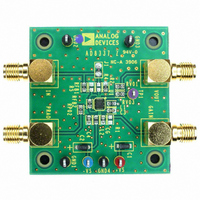AD8337-EVALZ Analog Devices Inc, AD8337-EVALZ Datasheet - Page 22

AD8337-EVALZ
Manufacturer Part Number
AD8337-EVALZ
Description
BOARD EVALUATION FOR AD8337
Manufacturer
Analog Devices Inc
Series
X-AMP®r
Specifications of AD8337-EVALZ
Channels Per Ic
1 - Single
Amplifier Type
Voltage Feedback
Output Type
Single-Ended
Slew Rate
625 V/µs
-3db Bandwidth
280MHz
Operating Temperature
-40°C ~ 85°C
Current - Supply (main Ic)
18.5mA
Voltage - Supply, Single/dual (±)
±2.5 V ~ 5 V
Board Type
Fully Populated
Utilized Ic / Part
AD8337
Silicon Manufacturer
Analog Devices
Application Sub Type
Variable Gain Amplifier
Kit Application Type
Amplifier
Silicon Core Number
AD8337
Kit Contents
Board
Lead Free Status / RoHS Status
Lead free / RoHS Compliant
Current - Output / Channel
-
Lead Free Status / RoHS Status
Lead free / RoHS Compliant, Lead free / RoHS Compliant
Available stocks
Company
Part Number
Manufacturer
Quantity
Price
Company:
Part Number:
AD8337-EVALZ
Manufacturer:
Analog Devices Inc
Quantity:
135
AD8337
The offset voltage effect of the AD8337, as with all VGAs, can
appear as a complex waveform when observed across the range
of V
a unique offset voltage (V
swept through its voltage range. The offset voltage profile seen
in Figure 15 is a typical example. If the V
modulated, the output is the product of the V
profile of the offset voltage. This is observed on a scope as a
small ac signal, as shown in Figure 74. In Figure 74, the signal
applied to the V
signal is slightly less than 4 mV p-p.
The profile of the waveform shown in Figure 74 is consistent
over a wide range of signals from dc to about 20 kHz. Above
20 kHz, secondary artifacts can be generated due to the effects
of minor internal circuit tolerances, as shown in Figure 75.
These artifacts are caused by settling and time constants of the
interpolator circuit and appear at the output as the voltage
spikes, as shown in Figure 75.
GAIN
–10
–10
10
–2
–4
–6
–8
10
–2
–4
–6
–8
–800
–800
8
6
4
2
0
8
6
4
2
0
voltage. Generated by multiple sources, each device has
V
V
Figure 74. Offset Voltage vs. V
S
S
V
V
= ±2.5V
INPUT
OUTPUT
= ±2.5V
S
S
INPUT
OUTPUT
–600
–600
= 2.5
= 2.5
GAIN
Figure 75. V
input is a 1 kHz ramp, and the output voltage
–400
–400
OS
OS
–200
–200
) profile while the GAIN input is
Profile for a 50 kHz Ramp
V
V
GAIN
GAIN
SPIKE
0
0
(mV)
(mV)
GAIN
200
200
for a 1 kHz Ramp
GAIN
400
400
GAIN
input voltage is
SPIKE
and the dc
600
600
800
800
Rev. C | Page 22 of 32
Under certain circumstances, the product of V
offset profile plus spikes is a coherent spurious signal within the
signal band of interest and indistinguishable from desired
signals. In general, the slower the ramp applied to the GAIN
Pin, the smaller the spikes are. In most applications, these
effects are benign and not an issue.
THERMAL CONSIDERATIONS
The thermal performance of LFCSPs, such as the AD8337,
departs significantly from that of leaded devices such as the
larger TSSOP or QFSP. In larger packages, heat is conducted
away from the die by the path provided by the bond wires and
the device leads. In LFCSPs, the heat transfer mechanisms are
surface-to-air radiation from the top and side surfaces of the
package and conduction through the metal solder pad on the
mounting surface of the device.
θ
Heat transfer away from the die is a three-dimensional dynamic,
and the path is through the bond wires, leads, and the six
surfaces of the package. Because of the small size of LFCSPs, the
θ
thermodynamic rules.
The θ
tab is soldered to the board and that there are three additional
ground layers beneath the device connected by at least four vias.
For a device with an unsoldered pad, the θ
becoming 138°C/W.
PSI (Ψ)
Table 2 lists a subset of the classic theta specification, Ψ
junction to top). θ
the case, involving the six outside surfaces of the package. Ψ
is a subset of the theta value and the thermal gradient from the
junction (die) to each of the six surfaces. Ψ can be different for
each of the surfaces, but since the top of the package is a fraction of
a millimeter from the die, the surface temperature of the package is
very close to the die temperature. The die temperature is calculated
as the product of the power dissipation and Ψ
surface temperature and power dissipation are easily measured, it
follows that the die temperature is easily calculated. For example,
for a dissipation of 180 mW and a Ψ
temperature is slightly less than 1°C higher than the surface
temperature.
BOARD LAYOUT
Because the AD8337 is a high frequency device, board layout is
critical. It is very important to have a good ground plane
connection to the VCOM pin. Coupling through the ground
plane, from the output to the input, can cause peaking at higher
frequencies.
JC
JC
is the traditional thermal metric used for integrated circuits.
is not measured conventionally. Instead, it is calculated using
JC
value of the AD8837 listed in Table 2 assumes that the
JC
is the metric of heat transfer from the die to
JT
of 5.3°C/W, the die
JC
nearly doubles,
JT
GAIN
. Since the top
and the
JT
(Psi
(XY)













